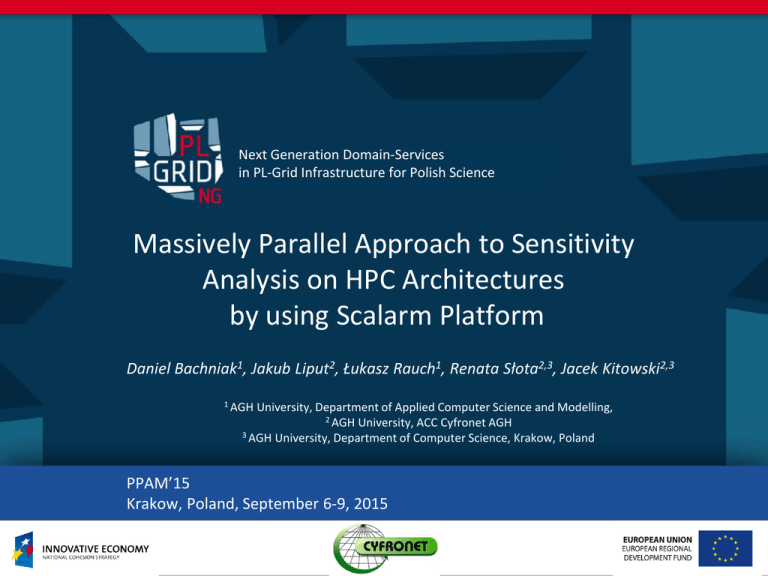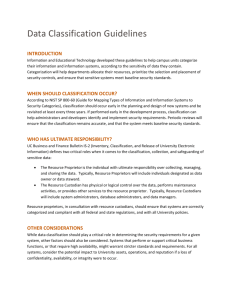Prezentacja programu PowerPoint
advertisement

Next Generation Domain-Services in PL-Grid Infrastructure for Polish Science Massively Parallel Approach to Sensitivity Analysis on HPC Architectures by using Scalarm Platform Daniel Bachniak1, Jakub Liput2, Łukasz Rauch1, Renata Słota2,3, Jacek Kitowski2,3 1 AGH University, Department of Applied Computer Science and Modelling, 2 AGH University, ACC Cyfronet AGH 3 AGH University, Department of Computer Science, Krakow, Poland PPAM’15 Krakow, Poland, September 6-9, 2015 Agenda Introduction Sensitivity Analysis and Scalarm • Scalarm architecture • Integration Sensitivity Analysis methods • Local methods • Global methods Example results • SA results for crankshaft deformation • Scalability tests Conclusions Design of production processes Rolling Welding Stamping Forging Dimensions: L > 10m, W > 30t Precision: ϕ < 50µ Flow forming How to design the production process? Build the model pp – Np input process properties Apply material properties pm – Nm input material properties OBJECTIVE – to obtain a set of optimal pp and pm !!! Apply boundary conditions Solve ill-posed inverse problem (optimization procedure) X Perform numerical simulation • • • • SENSITIVITY ANALYSIS Allows to determine influence of input parameters of the model on its output parameters. Select and configure SA method Sample of (Np+Nm) hypercube to receive N samples Perform N simulations of the process Analyse results Sensitivity Analysis Supervisor Separated approach Integrated approach Scalarm architecture Local methods1 Local sensitivity analysis investigates of model behavior around random point x of parameter space. 2D parameter space: S1 estimation: S2 estimation: x2 x2 x0 x1 x0 x0 x1 𝑓 𝑥1 − 𝑓(𝑥0 ) 𝑆1 = 𝑥1 − 𝑥0 >? Influence of parameter xi on the model output f(x) can be estimated by calculation of partial derivatives: 𝑓 𝑥2 − 𝑓(𝑥0 ) 𝑆2 = 𝑥2 − 𝑥0 Local methods2 Advantages: Application: • easy • often used • low computational cost: • problems with many parameters: 10 parameters -> 11 points 2 parameters -> 3 points 3 parameters -> 4 points • as a preliminary sensitivity analysis Disadvantages: • only local measurement ? ? x2 x0 ? ? ? ? ? x1 One step before global methods • Add new random points strategy: • Structured distribution strategy: x02 x01 x2 vs x2 x01 x02 x1 2 measurements-> 6 points x1 2 measurements-> 4 points Structured distribution strategy problem: periodical functions. S1 = 0, S2 = 0 x02 x01 Global methods – Morris Design Screening designs • • • 1 Qualitative estimation of the parameters importance One-At-a-Time (OAT) approach – Methods based on the OAT technique investigate the impact of the variation of each factor in turn 2/3 1/3 Morris Design 0 0 1/3 – Estimation of the main effect of the factor • Local measures at different points in the input space are computed i (x) : y ( x1 , , xi 1 , xi i , xi 1 , i , xk ) y(x) 2/3 1 x k 0,1 k • Points selection: each factor covers the whole interval in which it was defined • Sensitivity measures: estimation of the mean value i and standard deviation i i* i μ i* i σ Morris Design example Steps of algorithm: • normalization of parameters to range <0,1> • choose the smallest step: dx = 1/3 • random starting points: (for example 3 points) • create trajectories (one change for each direction): dx12 dx13 dx11 • calculate the means (u1 and u2) of derivatives for directions x1 and x2. • compare the means (u1 >? u2). Global methods – Factorial Design Uniform distribution strategy: • reduce the number of runs of the model by studying multiple factors simultaneously • commonly used for computationally intensive models 1 2 4 3 𝐸𝑓𝑓𝑒𝑐𝑡 = A high A low B high B low 𝑌ℎ𝑖𝑔ℎ − 𝑛 x1 𝑓 𝑝2 + 𝑓(𝑝4 ) 2 𝑓 𝑝1 + 𝑓(𝑝3 ) − 2 𝐸𝐴 = number of HIGH points number of LOW points • „level” factor as discretization parameter: Factorial Design, a) two factors, Two-level b) two factors, Three-level c) three factors, Two-level. 𝑌𝑙𝑜𝑤 𝑛 x2 Global methods – Sobol’ VarianceBased Method Total Sensitivity Indices = main effect + interactions total variance of the output partial variances Calculate first-order indices: Variance decomposition Calculate total-effect: main effects two parameters interactions higher order influences divide by: Variances estimation by using Monte-Carlo approach, and Sobol’ sequence. first order indices second order indices higher order indices 512 points of a two-dimensional a) standard random sequence and b) Sobol’ quasi-random sequence. Case study Investigation of parameters influence on the crankshaft deformation Supporting points of crankshaft: Deformation of crankshaft in a furnace at different times: Importance of parameters on deflection angle? Sensitivity Analysis Results (1) Cooling and heating sequence after forging operations during crankshaft manufacturing: Results of sensitivity analysis: a) b) Factorial Design Morris Design st. deviation t2 0.2 t1 t2 0.8 normalized sensitivity 0.08 mean 0.23 t1 0.77 normalized sensitivity 0.92 Results (2) Investigated parameters: • initial temperature (t_start) of normalization, • material parameters (Young modulus – E20, yield strength – Sp20) Results of sensitivity analysis: a) b) Factorial Design Sp20 Morris Design 0.01 0.05 0.08 Sp20 E20 0.01 E20 t_start 0.97 st. deviation mean 0.02 0.04 0.93 0.88 t_start normalized sensitivity normalized sensitivity c) Scatterplot for t_start parameter 8.00E-05 Beta_end 6.00E-05 Beta_end 4.00E-05 Linear (Beta_end) 2.00E-05 0.00E+00 -2.00E-05 780 800 820 840 860 880 t_start [°C] 900 920 940 960 Weak Scaling Efficiency where: d1 is the referential problem to calculate t1(d1) is the time of referential measurements for d1 tN(dN) is the time measured for N cores and problem size dN = N * d1 efficiency drop (due to Zeus’ queue-waiting time) Measurements of the weak scaling efficiency for Sensitivity Analysis conducted with use of Scalarm platform. Next Generation Domain-Services in PL-Grid Infrastructure for Polish Science Thank you for your attention ! https://scalarm.plgrid.pl http://scalarm.com Contact us: bachniak@agh.edu.pl j.liput@cyfronet.pl









